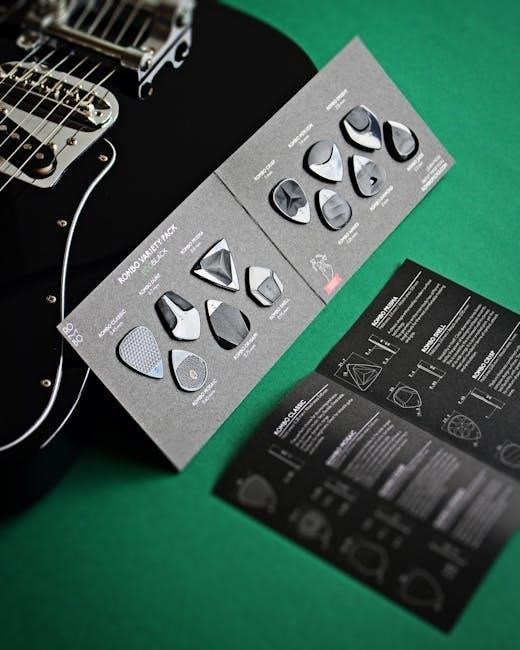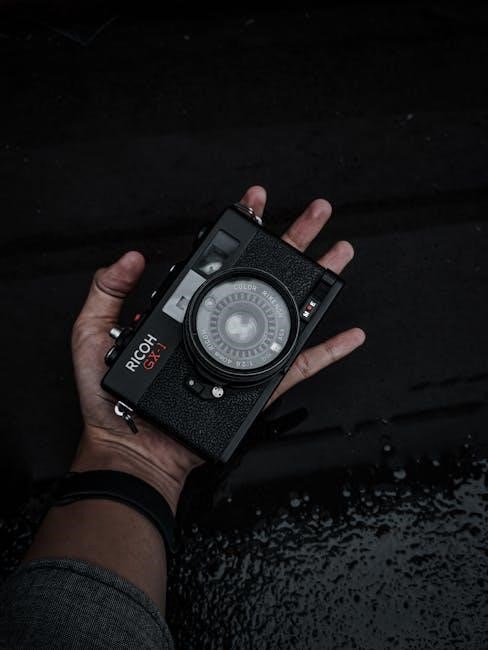The MXR 10 Band EQ is a powerful tool for precise tone shaping, offering 10 carefully chosen frequencies with +/-12dB boost or cut capabilities. Designed for both guitar and bass, it features input and output gain controls, true bypass switching, and a rugged enclosure, making it ideal for refining your sound with exceptional clarity and versatility.
Overview of the MXR 10 Band EQ
The MXR 10 Band EQ is a versatile graphic equalizer pedal designed for precise tone shaping. It features 10 frequency bands, each adjustable +/-12dB, allowing for detailed control over your sound. The pedal is powered by an 18-volt AC adapter, providing ample headroom for clean operation. With true bypass switching, it ensures no tone loss when disengaged. Its lightweight aluminum housing and second output for dual signal chains make it ideal for guitarists and bassists seeking enhanced tonal flexibility and reliability in various musical applications.
Key Features and Upgrades
The MXR 10 Band EQ boasts several standout features, including noise-reduction circuitry for quieter operation and true bypass switching to maintain signal integrity. It also includes a lightweight aluminum housing for durability and portability. The pedal offers a second output, enabling dual signal chains for enhanced versatility. With 10 carefully selected frequency bands, it provides +/-12dB of boost or cut, allowing precise tonal adjustments. These upgrades make it a robust and flexible tool for musicians seeking detailed sound shaping capabilities.

Setup and Powering the MXR 10 Band EQ
The MXR 10 Band EQ requires an 18-volt AC adapter (ECB-004) for power. Connect your guitar to the input jack and the pedal’s output to your amplifier or signal chain. Ensure secure connections for optimal performance and to maintain signal integrity.
Power Requirements and Adapter
The MXR 10 Band EQ requires an 18-volt AC adapter (ECB-004) for operation, providing twice the headroom of standard EQ pedals. The adapter is included, ensuring reliable power delivery. Using a DC Brick series power supply is also supported, offering flexibility for pedals boards. Proper power supply is crucial for maintaining the pedal’s performance and preventing noise or tone degradation. Always use the recommended adapter to ensure optimal functionality and avoid potential damage to the unit.

Connecting the Pedal in Your Signal Chain
Place the MXR 10 Band EQ in the effects loop of your amplifier for post-preamp tone shaping, or between your guitar and amp for preamp tone adjustment. Use the included 18-volt AC adapter (ECB-004) or a DC Brick series power supply for reliable operation. Connect your guitar to the input jack and your amplifier to the output jack. Experiment with different positions in your signal chain to achieve the desired tonal adjustments, utilizing the true bypass feature to maintain signal integrity when the pedal is disengaged.

Understanding the Controls
The MXR 10 Band EQ features 10 frequency sliders for precise tone shaping, each offering +/-12dB of boost or cut. The input and output gain controls allow for signal level adjustment, ensuring optimal tone matching and versatility in your setup.
Frequency Bands and Sliders
The MXR 10 Band EQ offers ten distinct frequency bands, each with a slider for precise control. These bands are strategically centered at key frequencies to address common tonal needs, from low-end warmth to high-end clarity. Each slider provides a range of +/-12dB, allowing for subtle adjustments or dramatic shifts in tone. This setup enables users to pinpoint specific frequencies, whether boosting or cutting, to achieve a balanced and polished sound tailored to their instrument and playing style. The sliders’ intuitive design makes it easy to dial in the perfect tone without unnecessary complexity.
Input and Output Gain Controls
The MXR 10 Band EQ features independent input and output gain controls, allowing precise adjustment of the signal level. These controls ensure optimal signal integrity, preventing loss or excessive gain. The input gain sets the pedal’s sensitivity, while the output gain matches the processed signal to your rig. This dual control system provides flexibility, enabling seamless integration into any setup. Whether boosting or attenuating, these controls help maintain a balanced tone, ensuring your sound remains clear and consistent. They are essential for tailoring the EQ’s response to your specific needs.

Using the MXR 10 Band EQ for Guitar
The MXR 10 Band EQ is a versatile tool for refining guitar tone, offering precise control over frequencies to enhance clarity and definition in various musical genres.
General Sound Shaping Techniques
With the MXR 10 Band EQ, guitarists can achieve precise tone refinement by boosting or cutting specific frequencies. Start by identifying problem areas in your tone. For a balanced sound, adjust low-end frequencies (e.g., 31.25 Hz) to eliminate muddiness and high-end frequencies (e.g., 2.5 kHz, 5 kHz) for clarity. Mid-range frequencies (e.g., 250 Hz, 500 Hz) can be tweaked to add warmth or reduce harshness. Experiment with subtle adjustments to enhance your guitar’s natural tone or create unique sonic landscapes. This versatility makes the MXR 10 Band EQ a valuable tool for shaping your sound.
Specific Frequency Adjustments for Clarity and Definition
To enhance clarity and definition, focus on high-end frequencies like 2.5 kHz and 5 kHz, boosting them to brighten your tone and improve articulation. For added precision, cut frequencies around 125 Hz to eliminate muddiness. Mid frequencies, such as 500 Hz, can be reduced to minimize harshness. Experiment with these adjustments to create a balanced, defined sound tailored to your guitar or bass, ensuring your tone stands out with clarity and precision in any mix.

Using the MXR 10 Band EQ for Bass
The MXR 10 Band EQ is highly effective for bass, covering key frequencies to enhance low-end clarity and definition. Adjust lower bands to tighten the bass response and ensure a balanced, resonant tone, while higher bands can refine articulation and presence, making it an excellent tool for shaping your bass sound with precision and versatility.
Covering Important Bass Frequencies
The MXR 10 Band EQ is optimized to cover the essential bass frequencies, allowing precise adjustments to enhance your tone. The lower bands (31.25Hz to 125Hz) focus on the fundamental low-end, ensuring tight, punchy bass notes. Midrange frequencies (250Hz to 500Hz) add clarity and definition, while higher bands (1kHz to 2kHz) refine articulation and presence. This range ensures comprehensive control over your bass tone, providing the ability to sculpt a balanced, professional sound in any musical setting. Whether you’re playing complex lines or deep grooves, the MXR 10 Band EQ delivers the tools needed to achieve a polished, resonant bass tone with exceptional versatility.
Optimizing Tone for Bass Instruments
The MXR 10 Band EQ excels at optimizing bass tones, offering precise control over critical frequencies. Its noise-reduction circuitry ensures a clean signal, while true bypass maintains tone integrity. The 18-volt operation provides ample headroom, reducing distortion. By adjusting the lower bands (31.25Hz–125Hz), you can tighten the low-end, while midrange adjustments (250Hz–500Hz) enhance clarity. Higher bands (1kHz–2kHz) refine articulation, allowing you to craft a balanced, professional bass sound with punchy lows and clear highs, perfect for dynamic performances.

Troubleshooting Common Issues
Address noise and fizz in upper frequencies by adjusting high bands carefully. Resolve muddy tones by cutting low-end frequencies (31.25Hz–125Hz) and ensuring proper signal chain placement.
Addressing Noise and Fizz in the Upper Frequencies
Noise and fizz in the upper frequencies can be mitigated by adjusting the high-band sliders (2kHz, 4kHz, 8kHz) carefully. Ensure the EQ is powered correctly with an 18-volt adapter to maintain headroom. Check connections for integrity and avoid excessive boosting, as this can introduce unwanted artifacts. If fizz persists, slightly reduce the gain levels or bypass the pedal to isolate the issue. Proper signal chain placement and minimizing external interference can also help resolve these common problems effectively.
Resolving Muddy Tone Problems
Muddy tones can be addressed by reducing low-frequency resonance. Lower the sliders for 31.25Hz, 62.5Hz, and 125Hz to eliminate muddiness without losing bottom end. Adjusting the input and output gain controls to optimal levels ensures clarity. Ensure proper power supply using the 18-volt adapter for headroom. Check connections for integrity and avoid excessive low-end boosting. Experimenting with the EQ’s placement in your signal chain, such as in the effects loop, can also help refine your tone effectively and reduce muddiness.

Advanced Tips and Techniques
Explore creative tone shaping by using the EQ as an effect, or set up a high-pass filter for precision by cutting low frequencies like 31.25Hz and 62.5Hz.
Setting Up a High Pass Filter (HPF)
To create a high pass filter, lower the 31.25Hz, 62.5Hz, and 125Hz sliders to -12dB. This reduces low-end muddiness, allowing higher frequencies to dominate, enhancing clarity and definition in your tone. Perfect for bass players seeking tighter low-end response or guitarists aiming to remove unwanted rumble. Adjust these frequencies to tailor the filter’s impact and achieve a cleaner, more focused sound across your instrument.
Using the EQ as an Effect
The MXR 10 Band EQ can be creatively used as an effects pedal to craft unique sounds. By strategically boosting or cutting specific frequencies, you can create dynamic tonal shifts, add resonance, or even mimic synthesizer-like textures. Use the sliders to emphasize harmonic overtones or carve out midrange frequencies for a scooped, modern sound. The true bypass design ensures no tone loss when disengaged, making it perfect for live performances or studio experimentation to add depth and character to your music. Experiment with extreme settings for bold, effects-like tonal transformations.
The MXR 10 Band EQ is a reliable, versatile tool offering precise tone control. Its durability and noise-reduction features make it ideal for professionals and casual players, enhancing sound and inspiring creativity.
The MXR 10 Band EQ offers precise tone shaping with 10 frequency bands, each adjustable by ±12dB. It features input and output gain controls, true bypass switching, and a lightweight aluminum housing. Upgraded noise-reduction circuitry ensures quiet operation, while the second output allows dual signal chains. This pedal is versatile for both guitar and bass, providing clarity and definition, making it a valuable addition for any musician seeking detailed control over their sound.
Final Tips for Getting the Most Out of the MXR 10 Band EQ
Experiment with small adjustments to refine your tone, as subtle changes can make a significant difference. Use the input and output gain controls to optimize your signal flow. For bass, focus on low-end clarity without muddying the tone, while for guitar, emphasize midrange definition for a balanced sound. Explore the pedal as an effect by creating unique frequency curves. Regularly clean the sliders to ensure smooth operation and maintain your desired sound. Save your favorite settings for quick recalls during performances or recordings.
